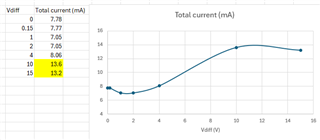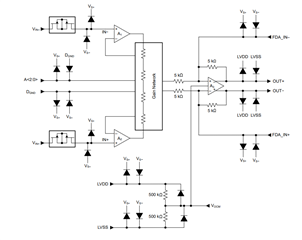Other Parts Discussed in Thread: PGA855
Tool/software:
Hi TI,
I am trying to characterize the device behavior when the VICM range is exceeded or inputs are overloaded/saturated, specifically, what would happen to the current consumption.
The device is powered by 30V and -4V, VCC = LVDD and vice versa, gain of 8V/V. Outputs are unloaded.
I did the characterization by sweeping the differential voltage applied to inputs, with IN- at GND.
And here is the current consumption of the device.

The increase in current significantly after 4V differential is concerning, because this would double the power budget, and the device would very likely interface with such voltages in end applications.
-What is happening when such voltages is applied to the device? Is the current increase expected?
-Any suggestion from TI to prevent this from happening? I think operating within the VICM is the right way, but what can I do before the input stage to operate the device better?
Thanks,
-HaoJie




